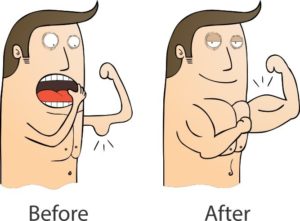Why should I workout if I’m just going to die anyway?
 Recently I was working with an older gentleman who had just had hip surgery. He really struggled, even with walking into the gym. After working with him for a few sessions, the one thing that really stood out was that he had never done any strength exercises in the past. He had no muscle tone.
Recently I was working with an older gentleman who had just had hip surgery. He really struggled, even with walking into the gym. After working with him for a few sessions, the one thing that really stood out was that he had never done any strength exercises in the past. He had no muscle tone.
So what happens to your body as it ages? What are the clear advantages to exercise and what happens to your body without exercise?
Changes start as early as the third decade of your life. After age 25-30 the average man’s heart rate declines by 1 beat per minute and his heart’s peak capacity drops by 5-10% per decade. A healthy 25 year old heart can pump 2.5 quarts of blood a minute, a 65 year old heart can’t get above 1.5 quarts and an 80 year old heart 1 quart. The result is fatigue and breathlessness with modest daily activities.
Men start to lose muscle in their 40s and will continue to lose it by 50%. Which will then contribute to weakness and disability.
The nervous system also changes. Reflexes are slower, coordination suffers and memory loss occurs.
Research shows that many of the changes attributed by aging are actually caused by disuse.
The difference between physical activity and exercise is this. Physical activities are activities that get your body moving such as gardening and walking your dog. Exercise is specifically planned and structured such as weight training or an aerobic class.
Inactivity is one of the major risk factors for heart disease. But like all muscles, the heart becomes stronger as a result of exercise, so it can pump more blood through your body with every beat. The resting heart rate of those who exercise is slower, because less effort is needed to pump blood.
Osteoporosis is responsible for 2 million fractures annually. And you guessed it, exercise can increase bone density in some seniors. Research shows that weight lifting and even just walking can increase bone density in the hip and spine. Weight lifting causes stress on the bones as the muscles contract (which causes the bone to thicken) and walking causes stress on the bones which stimulates them to grow. In 2 different studies, one of men 50-70 years who lifted weights 3 times a week and the other of women 40-70 years of age who lifted twice a week for one year showed an increase in bone density in the hips and lower back.
Perhaps the most dramatic example comes from a Harvard study that demonstrated improvements in 87-90 year old nursing home patients who were put on a weight lifting program. This study evaluated muscle function but it also looked at mortality. The latter study found that previously sedentary men who began exercise after the age of 45 enjoyed a 24% lower death rate than those who remained inactive. The benefits were linked to an amount of exercise equivalent to walking for about 45 minutes a day at about a 17 minutes per mile pace. On average, sedentary people gained about 1.6 years of life expectancy from becoming active later in life. (Harvard)
The benefits of exercise are clear. Although you can see improvements in your health even in your 80’s and 90’s, why wait? The younger you are in your adult life that you begin making exercise a part of your regular routine the more beneficial it will be. And when you do age your body will be more resilient. Giving you more life in your years. So what say you? Is exercise a regular part of your daily routine and if not, isn’t it time to make time for it? Email me if you have any questions, I’m glad to be of service.